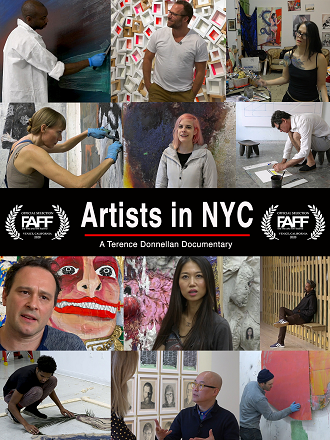
Artists in NYC 2019
Distributed by Blasket McManus Productions, 707 Ninth Avenue, Suite 1RN, NY, NY 10019
Produced by Sanja Frank and Terence Donnellan
Directed by Terence Donnellan
Streaming, 67 mins
General Adult
Art; Art History
Date Entered: 10/12/2020
Reviewed by Kara Van Abel, Reference Librarian & Liaison to the Collat School of Business & Department of Theatre, University of Alabama at BirminghamArtists in NYC features real visual artists living and working in New York City. The artists interviewed are from varying backgrounds, use different media, and are at different points in their careers. The film begins with mentions of famous artists who were misunderstood and undervalued by their contemporaries. Then it moves right into clips of artists engaging with and talking about their work, background, etc. Any questions that prompt the artists’ responses have been edited out, and the result is that the interviews seem disconnected from one another. The central theme of art and culture sometimes gets lost as each artist attempts to describe their work, its meaning, and how their lived experience informs their art. Most of the artists are filmed individually in their private studios or alone in galleries. Some of the artists briefly mention why they came to New York or what prompted them to move there (the community of artists). Despite being part of the title, New York isn’t explored as a haven for artists, and the film misses an opportunity to show the artistic community that exists in NYC.
Also missing from the film is an exploration of how art interacts with culture. As an example, the artist Michael David, uses swastikas as subjects in some of his work. This is shown, but there is no deeper dive into the cultural significance of swastikas past or present. What is lacking here is other perspectives from art historians, critics, curators, or lovers. Incorporating these other perspectives could lend more context to the artwork and its effect on culture.
The majority of the film focuses on artists working with more traditional, physical media to create their visual art, however during the last 20 minutes, the film pivots and shows artists working with digital media formats. This leads to a brief discussion of the future of art in this new medium. Closing moments of the film pivot again to capture an artist as he shares how his art serves as a visual representation for his recovery from drug addiction.
The film’s primary value is in its depiction of a wide range of artists. Their views and work are displayed with care to the audience. However, the film lacks a clear narrative and feels disjointed at times. For those reasons, the title is recommended with reservations.